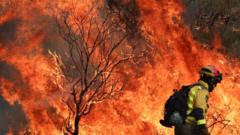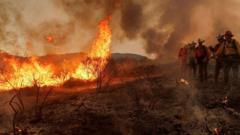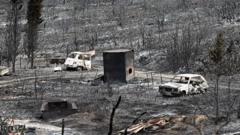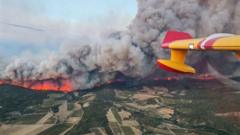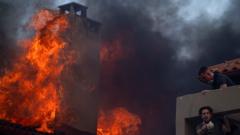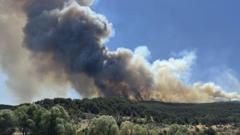Crews are attempting to save the Doerner Fir, a 450-year-old tree, from a wildfire that has already burned significant height off its top, raising concerns over its future.
Oregon Firefighters Battle Blaze Threatening Historic Doerner Fir Tree
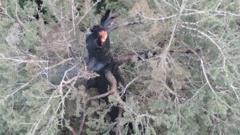
Oregon Firefighters Battle Blaze Threatening Historic Doerner Fir Tree
Efforts are accelerating to protect one of the world’s tallest trees amid a raging fire.
Firefighters in Oregon are working tirelessly to save the Doerner Fir, which stands over 325 feet tall and is one of the oldest trees in the world. The tree has been engulfed by flames since Saturday, losing roughly 50 feet from its peak. Experts warn that the ongoing blaze could affect the tree's standing in global height rankings.
Forecasters predict warm and dry conditions along Oregon's Coast Range will complicate firefighting efforts. To combat the flames, crews are considering innovative measures, such as creating scaffolding to access and extinguish the fire at elevated areas of the tree.
The origin of the fire is still unknown, although lightning has been ruled out as a possible cause. According to Megan Harper, a spokesperson for the federal Bureau of Land Management, an infrared drone inspection revealed no signs of active flames or smoke at the tree's upper sections, but it did detect heat within a cavity located approximately 280 feet up its trunk.
Harper expressed concern about the tree's future, noting, "We've lost about 50 ft of it, just from fire and pieces falling out... I don't know where it'll stand after this, but it's still a magnificent tree." Despite the damage, she reassured that the likelihood of the tree burning down entirely is low due to its substantial size and mass.
To reduce fire activity around the top of the tree, the Coos Forest Protective Association has implemented helicopter bucket drops. Additionally, sprinkler systems and containment lines have been established around the base for protection. A helicopter standby remains in place to assist in ongoing efforts.
Forecasters predict warm and dry conditions along Oregon's Coast Range will complicate firefighting efforts. To combat the flames, crews are considering innovative measures, such as creating scaffolding to access and extinguish the fire at elevated areas of the tree.
The origin of the fire is still unknown, although lightning has been ruled out as a possible cause. According to Megan Harper, a spokesperson for the federal Bureau of Land Management, an infrared drone inspection revealed no signs of active flames or smoke at the tree's upper sections, but it did detect heat within a cavity located approximately 280 feet up its trunk.
Harper expressed concern about the tree's future, noting, "We've lost about 50 ft of it, just from fire and pieces falling out... I don't know where it'll stand after this, but it's still a magnificent tree." Despite the damage, she reassured that the likelihood of the tree burning down entirely is low due to its substantial size and mass.
To reduce fire activity around the top of the tree, the Coos Forest Protective Association has implemented helicopter bucket drops. Additionally, sprinkler systems and containment lines have been established around the base for protection. A helicopter standby remains in place to assist in ongoing efforts.




